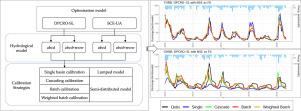Accurate calibration of hydrological models with evolutionary computation multi-method ensembles
IF 4.6
2区 环境科学与生态学
Q1 COMPUTER SCIENCE, INTERDISCIPLINARY APPLICATIONS
引用次数: 0
Abstract
Climate change significantly impacts the hydrological cycle, posing challenges for regional water resource management and Sustainable Development Goals. Hydrological modelling is essential for planning and adaptation, being necessary to dispose different mathematical computing tools to be able to calibrate them properly. This study introduces the Dynamic Probabilistic Coral Reefs Optimization algorithm with Substrate Layer (DPCRO-SL), a multi-method ensemble approach, to enhance hydrological model calibration. The algorithm was applied to the hydrological model in two Spanish river basins, using lumped and semi-distributed structures to test adaptability. Results were compared with the SCE-UA algorithm, a benchmark in hydrology, using metrics such as Nash–Sutcliffe Efficiency (NSE), Mean Squared Error (MSE), Kling–Gupta Efficiency (KGE), and Percent Bias (Pbias). For instance, in THRB basin during the test period, the proposed DPCRO-SL algorithm achieved NSE = 0.765, KGE = 0.875, MSE = 171.9, and Pbias = 2.6, whereas the reference SCE-UA algorithm obtained NSE = 0.689, KGE = 0.748, MSE = 227.8, and Pbias = –14.8. DPCRO-SL consistently outperformed SCE-UA, especially in test scenarios reflecting forward projections. These findings underscore the potential of DPCRO-SL as a robust tool for hydrological modelling and climate adaptation, offering improved accuracy and reliability in model calibration.

基于进化计算多方法组合的水文模型精确定标
气候变化对水文循环产生重大影响,对区域水资源管理和可持续发展目标构成挑战。水文建模对于规划和适应是必不可少的,必须配置不同的数学计算工具才能正确地校准它们。本文介绍了一种多方法集成方法——基于基材层的动态概率珊瑚礁优化算法(dcro - sl),以增强水文模型的校准。将该算法应用于西班牙两个流域的abcd水文模型,采用集总和半分布结构进行适应性测试。使用Nash-Sutcliffe效率(NSE)、均方误差(MSE)、Kling-Gupta效率(KGE)和百分比偏差(Pbias)等指标,将结果与水文学基准SCE-UA算法进行比较。例如,在THRB流域测试期间,DPCRO-SL算法得到的NSE = 0.765, KGE = 0.875, MSE = 171.9, Pbias = 2.6,而参考SCE-UA算法得到的NSE = 0.689, KGE = 0.748, MSE = 227.8, Pbias = -14.8。DPCRO-SL一直优于SCE-UA,特别是在反映前瞻性预测的测试场景中。这些发现强调了DPCRO-SL作为水文建模和气候适应的强大工具的潜力,提高了模型校准的准确性和可靠性。
本文章由计算机程序翻译,如有差异,请以英文原文为准。
求助全文
约1分钟内获得全文
求助全文
来源期刊

Environmental Modelling & Software
工程技术-工程:环境
CiteScore
9.30
自引率
8.20%
发文量
241
审稿时长
60 days
期刊介绍:
Environmental Modelling & Software publishes contributions, in the form of research articles, reviews and short communications, on recent advances in environmental modelling and/or software. The aim is to improve our capacity to represent, understand, predict or manage the behaviour of environmental systems at all practical scales, and to communicate those improvements to a wide scientific and professional audience.
 求助内容:
求助内容: 应助结果提醒方式:
应助结果提醒方式:


